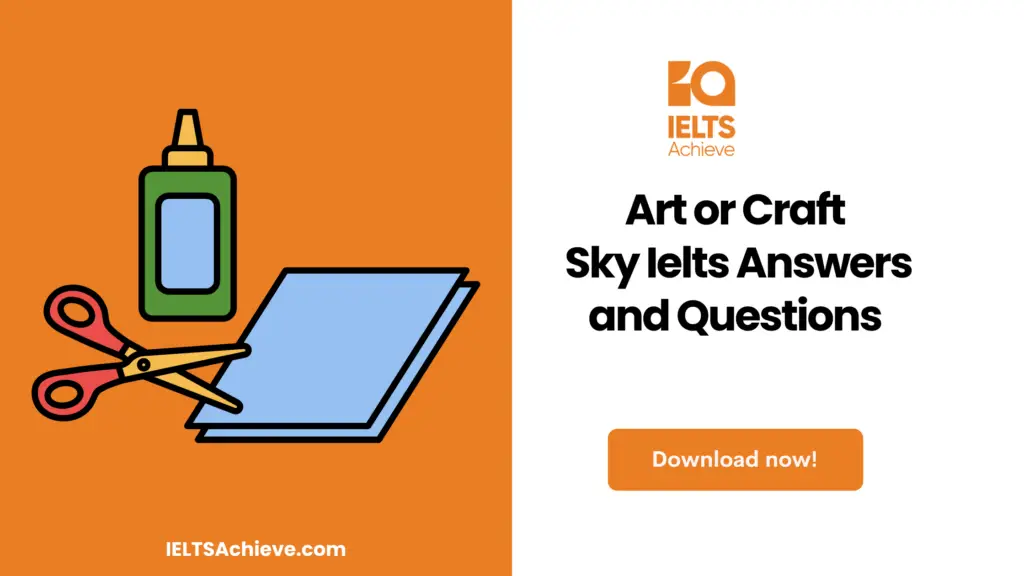The Blog post contains the following IELTS Reading Questions:
- IELTS Reading Table Completion
- IELTS Reading True/False/Not given
- IELTS Reading Multiple Choice Questions

IELTS reading passage – Art or Craft
Art or Craft
A. Craftsmen have traditionally been considered distinct from artists. Craftsmen, such as woodworkers and plasterers, had their own guild, whereas the artist was thought to be a more solitary being confined to an existence in a studio or attic. Furthermore, whereas craftsmen could rely on a reasonably consistent income, artists were frequently living on the breadline, and the term “starving artist” became a synonym to describe the impoverished existence of artists in general. Even today, the lives of a craftsman and an artist could not be more dissimilar. However, what exactly distinguishes craft from art, both practically and philosophically?
B. The nature of the finished product or piece is one of the primary distinctions between art and craft. Fundamentally, the idea of craft has traditionally been connected to the creation of goods that are useful or practical. Contrarily, art is not constrained by the confines of practicality. While an artist’s creation is often without a practical purpose, a craftsman’s teapot or vase should typically be able to carry tea or flowers. In actuality, the sole purpose of art and its existence is to simply “be,” which is why Dada artist Meret Oppenheim made the fur lined teacup. The “cup” as such was evidently never meant to be used in a practical manner, any more than a chocolate teapot possibly was.
C. Artistry in craftsmanship is consequently simply a by product because the number one focus is on what something does, now no longer what it is. The opposite is real for artwork. Artistic merchandise attraction is purely at the degree of the imagination. As the prestigious philosopher, Kant, stated, ‘At its best, artwork cultivates and expands the human spirit.’ Whether the artist answerable for a chunk of artwork has sufficient expertise to acquire that is any other matter. However, the purpose of all artists stays the same: to produce a piece that also goes beyond the mundane and uplifts the viewer. In contrast, the world of the craftsman and his paintings stay lodged firmly in the practicality of the everyday world. An item produced through an artist is consequently essentially specific from the one produced through a craftsman
D. Differences among the 2 disciplines of art and craft make bigger additionally to the method required to produce the finished object. The British philosopher R.G. Collingwood, who set out a list of standards that distinguish art from craft, focused on the distinction between the two subjects in their ‘planning and execution. With a craft, Collingwood argued, the ‘result to be acquired is preconceived or thought out before being arrived at.’ The craftsman, Collingwood says, ‘knows what he desires to make before he makes it’. This foreknowledge, consistent with Collingwood, has to now no longer be vague but precise. In fact, such making plans are taken into consideration to be ‘indispensable’ to craft. In this respect, the craft is essentially one-of-a-kind from the artwork. Art is located by Collingwood at the different end of the creative continuum, the introduction of art being described as a method that evolves non-deterministically. The artist is, therefore, just as unaware as everybody else as to what the end product of the introduction will be, while he’s actually in the process of creating. Contrast this with the craftsman who already knows what the end product will seem like before she or he has even begun to create it.
E. Since the artist isn’t always following a set of standard guidelines in the process of creation, she or he has no guidelines like the craftsman. Whilst the desk or chair created by the craftsman, for example, has to conform to certain expectations in look and design, no such limitations are imposed on the artist. For it is the artist alone who, via a trial-and-error approach, will create the final object.
F. The object merely evolves over time. Whereas the craftsman can pretty correctly predict when a product can be completed taking technical methods into account, the artist can do no such thing. The artist is at the mercy of inspiration alone and pretty apart from not being capable of having a projected completion date, might also additionally never be capable of assuring that the object will be completed at all. Unfinished symphonies by wonderful composers and works of literature by no means finished through their authors testify to this.
G. Having no particular end goal in mind, the emphasis at the finished product which is true of craftsmanship is placed Instead on the act of creation itself with the artist. The creation of the work of art is an exploration and a battle and direction of discovery for the artist. It could be said that the artist is producing as much for himself as for people who will view the finished product. This act of creation is very distinct from the manufacturing of an object that is crafted, therefore. The aim of creating craftwork is monetary compensation. Craft is produced for purchase and is basically a money-generating industry. Any craftsman who observed the artistic approach to creation might quickly be out of a job. Craftsmen are predicted to deliver, artists are not. This is probably the maximum fundamental distinction that separates the craftsman from the artist.
Art or Craft reading questions
Questions 1-10
Complete the table below. Choose 10 answers from the box and write the correct letter, A-L, next to questions 1-10.
- the finished product has an emotional and spiritual level appeal
- the final product has no ambition to be anything more than it appears.
- only the functional use is considered for the final object.
- no practical purpose as such is imagined for the created object.
- the process of creation is actually a means to an end.
- whether there is an end product or not, the product is itself secondary to the process of production.
- not having to stick to a set of rules, the process is a matter of experimentation
- there is no line of error for experimentation, all of the process are following a set of rules.
- the goal is defined from the outset
- the process is undefined and fluid
- it is useful but not commercially practical
- the production process is a mixture of following experimentation and guidelines.
Unlock your full potential in the IELTS Reading section – Visit our IELTS Reading Practice Question Answer page now!
Recommended Questions:
Renewable Energy IELTS Reading Question with Answer
Questions 11-12
Do the following statements agree with the information given in the Reading Passage? In boxes 11-12 on your answer sheet, write
TRUE if the statement is true
FALSE if the statement is false
NOT GIVEN if the information is not given in passage
11. One of the key differences between craft and art is the type of final item or piece.
12. Artists also have to follow a set of rules like craftsmen.
Enhance your skills in identifying information as True, False, or Not Given. Click here to discover expert strategies and techniques for mastering this question type in the IELTS Reading section.
Questions 13-14
Choose the correct letter A, B, or C. Write the correct option letter in boxes 13-14 on your answer sheet.
13. Which of the following people can predict the time when the object production will get completed?
- Craftsmen
- Artist
- None of these
14. Which of the following is the most basic difference between a craftsman and an artist?
- The time required to finish the product
- The process of making the product
- The prediction to deliver.
Unlock your full potential in the IELTS Reading section – Visit our IELTS Reading Practice Question Answer page now!
Recommended Questions:
Renewable Energy IELTS Reading Question with Answer
Art or Craft Reading answers
1. A
2. B
3. D
4. C
5. F
6. E
7. G
8. H
9. J
10. I
11. TRUE
12. FALSE
13. A
14. C

We hope you found this post useful in helping you to study for the IELTS Test. If you have any questions please let us know in the comments below or on the Facebook page.
The best way to keep up to date with posts like this is to like us on Facebook, then follow us on Instagram and Pinterest. If you need help preparing for the IELTS Test, join the IELTS Achieve Academy and see how we can assist you to achieve your desired band score. We offer an essay correction service, mock exams and online courses.

